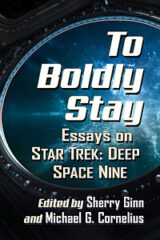When in 1993 the first episode of Star Trek: Deep Space Nine (DS9) aired, it was the beginning of a very unusual show, believed by many Star Trek fans to be the best window into the Federation cosmos.
 After 176 episodes, set in 2369-2375 and, as such, happening almost simultaneously to the timelines of Star Trek: The Next Generation and Star Trek: Voyager, DS9 was terminated in 1999 after seven seasons.
After 176 episodes, set in 2369-2375 and, as such, happening almost simultaneously to the timelines of Star Trek: The Next Generation and Star Trek: Voyager, DS9 was terminated in 1999 after seven seasons.
DS9 in many ways was distinctly different from previous Star Trek/Roddenberry projects, and in a way it undermined and revolutionized the franchise’s image and reception; in a very positive way, most would say.
The strong focus on story arcs that span several years was a new concept then. Before the show, it was mostly unheard of, as traditionally US TV stations preferred to have complete and finished episodes they could broadcast without particular order at any time. Today, the story arc is, more or less, the major force that keeps fans watching their favorite shows, and this aspect possibly is at the core of “binge watching.” (Val Nolan’s text on serialized storytelling in this volume is worth mentioning.)
Instead of the usual main story, where a spacecraft crew traveled across the galaxy to meet strange and new cultures, DS9’s action took place, for the most part, on a space station, a previously Cardassian-owned ore processing plant and prison facility originally in orbit of the planet Bajor named “Terok Nor,” and interstellar visitors arrived at the station.
Another difference to other shows of the Star Trek cannon was the emphasis on religious/spiritual aspects of life for intergalactic communities. Previous franchise series either strictly evaded the topic or ridiculed the idea of gods, prophets and religions or resolved questions about it and their meanings for alien cultures in the usual scientific and philosophical Starfleet cannon of analysis with technological tools. (After all, so far religion, myth and the supernatural were more at home in another sci-fi universe, namely the Star Wars franchise).
Furthermore, the show in a number of episodes presented very bleak and dystopian impressions of life in the Federation, including revolution and armed resistance by the Maquis, former Federation members. At the fringe of the known galaxy quadrant and only a tip through a stable wormhole away from the mostly unknown Gamma Quadrant, the station served several philosophical, colonial, military and representative purposes.
It was actually the new “last frontier.”
The Federation outpost with its multi-ethnic mixed crew had to face the most unusual tasks, possible only because of DS9’s location. Of course, the show was also about (Federation) politics and Machiavellian tactics. Interracial conflicts and the show’s structure, that often covered several episodes, combined with many psycho-social relationships, were the ingredients for a grand sci-fi TV show. It created a superb density hardly ever seen on screens at home. “… Deep Space Nine became the most richly complex and (perhaps) the most ‘sci-fi’ series in the entire Star Trek pantheon, in so much as it used the genre to advance important conversations about race, gender, faith, and the way in which societies tell stories.”
With that variety of topics and room for conflict and drama, editors Michael G. Cornelius and Sherry Ginn in the book at hand compiled the works of eight authors who for the first time shed light on the many aspects of this Star Trek show. Altogether eleven texts split into creating the narrative and serialized story building and in the second part with presenting the topics race, gender and religion, deal with yet another micro-cosmos of fictional future life under Federation conditions. Fellow contributors are Rowan Bell, Dylan Reid Miller, Florent Favard, Douglas Rasmussen, and Franklin R. Halprin.
All the essays are fun to read, and they pin their subjects just as you would expect, thereby considering the uniqueness of the setting on DS9. Two texts, however, may stand out, namely Erin Bell’s musing on “Odo’s Rhizomatic Journey Toward Selfhood,” and “Sisko’s Conversion Experience and the Secularism of William James” by Drew Chastian.
“Personal identity – not national ideology – is at the heart of every journey in Deep Space Nine. It is this type of exploration – boldly going where no one had gone before in the Trek universe, deep into the heart of the self – that creates optimal conditions for broader, more expansive exploration into difficult subjects that Star Trek had previously only cursorily deigned to examine: explorations of race, gender and faith, all wrapped up in and made possible by a narrative that re-examined its own relationship to time by altering its relationship to space.”
A must for Star Trek audiences and those who muse about the future of mankind living in communities in space.
Review by Dr. A. Ebert © 2022
Sherry Ginn and Michael G. Cornelius (eds.). To Boldly Stay: Essays on Star Trek: Deep Space Nine. McFarland, 2022, 219 p.
